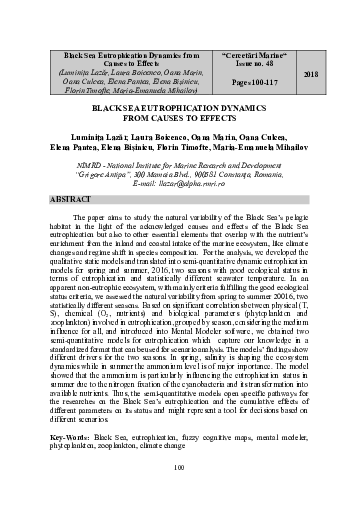Black Sea Eutrophication Dynamics from Causes to Effects
DOI:
https://doi.org/10.55268/CM.2018.48.100Keywords:
Black Sea, eutrophication, fuzzy cognitive maps, mental modeler, phytoplankton, zooplankton, climate changeAbstract
The paper aims to study the natural variability of the Black Sea’s pelagic habitat in the light of the acknowledged causes and effects of the Black Sea eutrophication but also to other essential elements that overlap with the nutrient’s enrichment from the inland and coastal intake of the marine ecosystem, like climate changes and regime shift in species composition. For the analysis, we developed the qualitative static models and translated into semi-quantitative dynamic eutrophication models for spring and summer, 2016, two seasons with good ecological status in terms of eutrophication and statistically different seawater temperature. In an apparent non-eutrophic ecosystem, with mainly criteria fulfilling the good ecological status criteria, we assessed the natural variability from spring to summer 20016, two statistically different seasons. Based on significant correlations between physical (T, S), chemical (O2, nutrients) and biological parameters (phytoplankton and zooplankton) involved in eutrophication, grouped by season, considering the medium influence for all, and introduced into Mental Modeler software, we obtained two semi-quantitative models for eutrophication which capture our knowledge in a standardized format that can be used for scenario analysis. The models’ findings show different drivers for the two seasons. In spring, salinity is shaping the ecosystem dynamics while in summer the ammonium level is of major importance. The model showed that the ammonium is particularly influencing the eutrophication status in summer due to the nitrogen fixation of the cyanobacteria and its transformation into available nutrients. Thus, the semi-quantitative models open specific pathways for the researches on the Black Sea’s eutrophication and the cumulative effects of different parameters on its status and might represent a tool for decisions based on different scenarios.
Downloads
Published
How to Cite
Issue
Section
License
This is an open access journal, which means that all content is freely available without charge to the user or his/her institution. Users are allowed to read, download, copy, distribute, print, search, or link to the full texts of the articles, or use them for any other lawful purpose, without asking prior permission from the publisher or the author. This is in accordance with the BOAI definition of open access.





